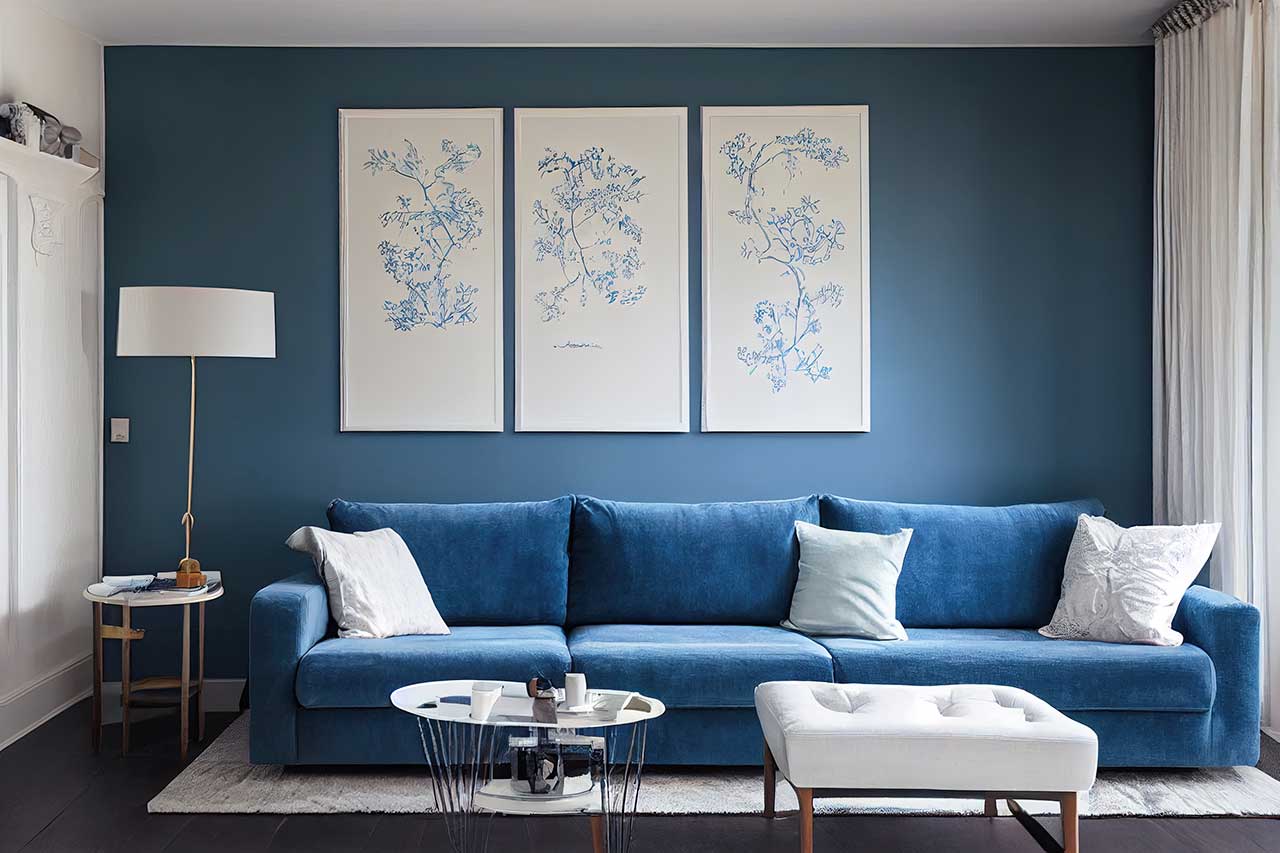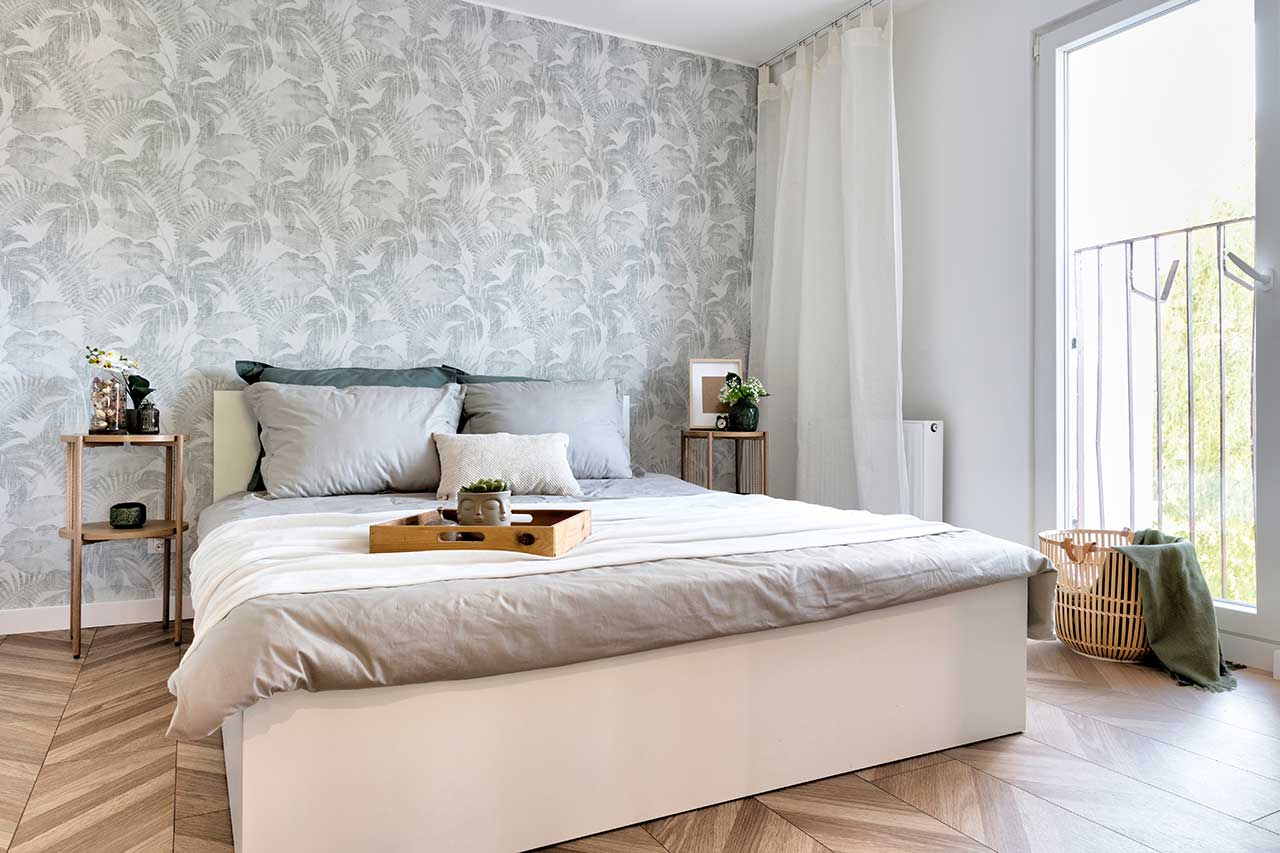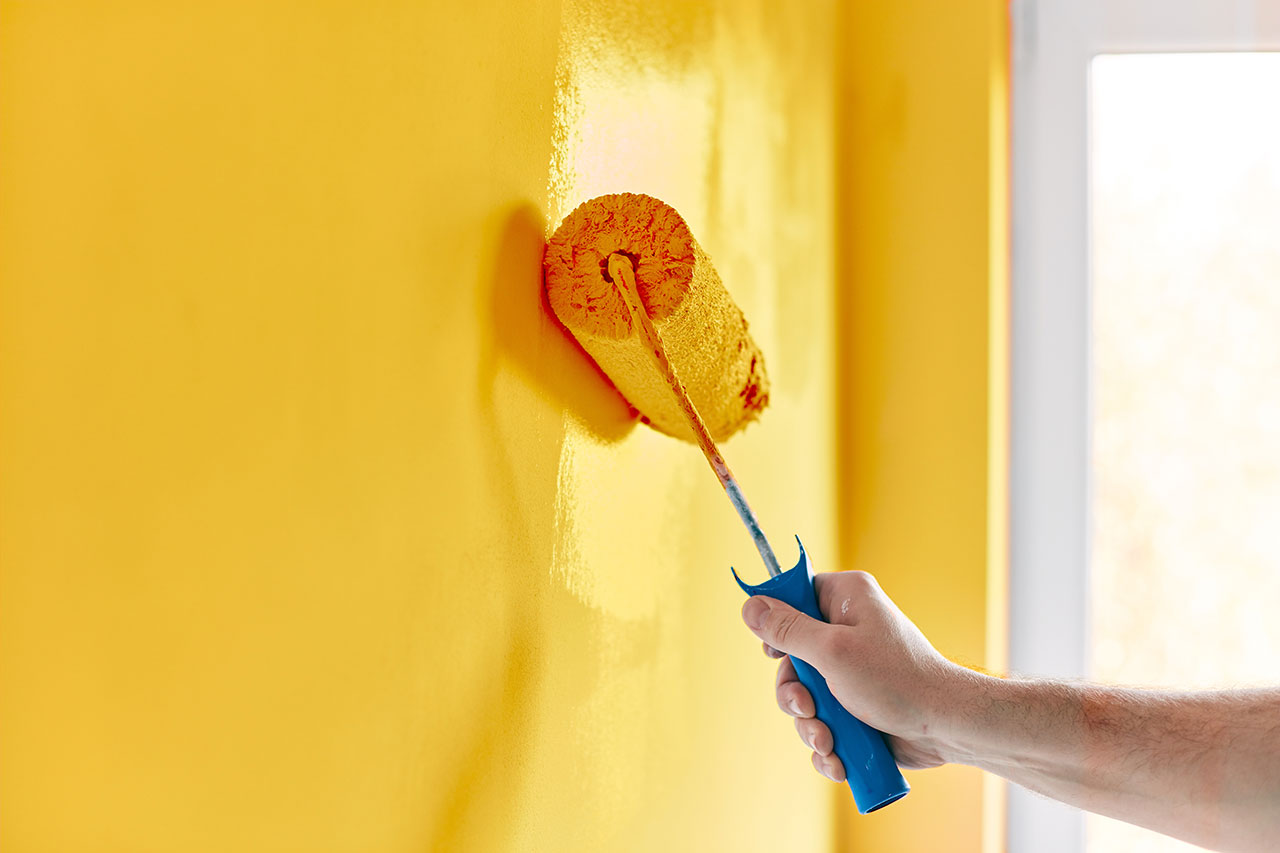

Left/Top: Photo: photosbysabkapl / Adobe Stock
Bottom/Right: Photo: 2ragon / Adobe Stock
Wallpaper versus paint—these are the two major options when homeowners look to redo their walls. Each has advantages and disadvantages, depending on your budget, project size, and what you are going for. For instance, wallpaper lasts longer but typically costs more and is more difficult to remove when necessary. As a matter of fact, removing wallpaper costs up to $1,200 in some cases.
Follow along for a deeper dive into painting versus wallpaper and how each can suit your needs.
On This Page:
- What Is Wallpaper?
- What Is Paint?
- Appearance
- Cost
- Durability and Upkeep
- Installation
- Life Span
- Environmental Impact
- Resale Value
- Removal
- Which Is Better?
- Wallpaper and Paint vs. Other Options
What Is Wallpaper?
As the name suggests, wallpaper is paper that affixes to your walls. This decorative element is available in various colors and designs to suit nearly any home aesthetic. Wallpaper is typically sold in large rolls and applied with wallpaper glue or a related adhesive.
This interior decorating choice dates back to the 1600s and was popular among those in the European Renaissance gentry class. Modern technologies allow for even more aesthetic diversity with the introduction of custom printing of homespun designs and textured walls.
What Is Paint?
Paint is pretty straightforward, but to go into more detail, it’s a liquid substrate available in a myriad of colors and types. Once applied, it dries into a solid film on your wall. Unlike wallpaper, paint is also a go-to for the exterior of a house.
Paint is one of the oldest decorating tools in human history, going as far back as 40,000 years ago. However, modern paint consists mostly of oils, water, and various binders, whereas ancient paint was mostly charcoal. There are many wall-painting techniques out there to suit modern consumers.
Appearance
Appearance is in the eye of the beholder, so neither paint nor wallpaper offers a “better” viewing experience, but there are some differences. Paint comes in a wide range of solid colors, while wallpaper offers unique designs with visual aspects beyond solid colors.
| Wallpaper | Paint |
|---|---|
| Wide range of designs | Tough to make designs |
| Fewer solid colors are available | Great for solid colors |
| Diverse array of textures | Textures only available in special circumstances |
Wallpaper
Wallpaper makes unique and eye-catching designs possible. If you are envisioning a trendy design instead of a solid color, or even multiple colors, go with wallpaper. This material is not often available as a solid color for obvious reasons. Solid colors are not why homeowners shop for wallpaper. However, many wallpaper designs out there focus on a particular color with added texture and nuance in small doses.
Paint
Creating a design with paint requires a lot of forethought, special tools like stencils, and opportunities to make time-consuming mistakes. You will also need a variety of paintbrush types to extend those designs to corners and trims.
Paint ships as a solid color, making this the ideal option for simple yet elegant walls. Swapping out to a new color can drastically change the vibe of an interior space. It is possible to add some texture to wall paint, but it requires special additives and expert techniques. Textured painting is sometimes called faux painting by professionals. Faux painting a wall costs $2 to $20 per square foot.
Get a Quote from a Wallpaper ProCost
When installing wallpaper, you’ll benefit from hiring a pro to complete the job, whereas paint is more DIY-friendly. You’ll need supplies when applying a coat of paint, such as primer, brushes, and paint trays, but this pales in comparison to the supplies needed for a successful wallpaper installation.
| Wallpaper | Paint |
|---|---|
| Higher upfront cost | Lower upfront cost |
| Almost always requires a pro | DIY-friendly |
| Both inexpensive options and expensive options | Both inexpensive options and expensive options |
Wallpaper
A roll of wallpaper costs $15 to $30, but required supplies include wallpaper glue, seam rollers, smoothing tools, levels, utility knives, and more. Additionally, hiring a pro to install wallpaper costs $2 to $7 per square foot. Installing wallpaper is best left to the professionals unless you have plenty of experience with this finicky process. Keep in mind that complex wallpaper designs with multiple textures cost more than plain designs.
Paint

Photo: Artur Nyk / Adobe Stock
Paint offers lower upfront costs than wallpaper due to the cost of the paint itself and the required supplies. A gallon of paint costs $15 to $50 and all of the supplies, including brushes and trays, add up to around $50. Painting a wall on your own is a particularly DIY-friendly project with little or no obvious hurdles. If you’d like to leave it to a pro, professional painters do the job quicker and with better results.
When looking at wallpaper versus paint costs, painting requires lower upfront costs. However, the cost ranges are comparable when you factor in high-end offerings. Faux paints, textured paint jobs, and other advanced techniques cost more than standard paints and primers. The cost of an interior painting project ranges between $950 and $2,940, with a national average of $1,940.
Durability and Upkeep
Both options require a certain level of maintenance, but paint is slightly less durable and doesn’t last as long as wallpaper. Painted walls need a new coat every three to five years, while wallpaper lasts anywhere from 10 to 15 years. However, adding a coat of paint is much easier than finding the exact wallpaper type to fix a noticeable blemish.
| Wallpaper | Paint |
|---|---|
| Lasts 10 – 15 years | Requires a new coat every 3 – 5 years |
| Most wallpaper is washable by design | Washable designs are available but cost extra |
| Peels and cracks with moisture exposure | Resists moisture and heat |
Wallpaper
Professionally-installed wallpaper lasts up to 15 years and even longer in some cases. Wallpaper is the better “set it and forget it” option here. Most wallpaper is washable by design, meaning it is easy to clean up spills, remove stains, and keep up the appearance.
Use wallpaper glue to repair minor cracks, though peels require more extensive repairs and outright replacement in some cases. Wallpaper does not do well with heat, moisture, and humidity, so keep it away from bathrooms.
Paint
Professionally-applied paint lasts up to ten years but requires fresh coats of paint every three to five years, in addition to semi-regular touch-ups. Paint is not typically washable, though it reacts well to dedicated cleaning agents. Fully washable paint is available, but for an added cost.
Consider springing for washable paint in highly-traffic areas like kids’ rooms and living rooms. Generally speaking, oil-based paint is the least-washable type. For blemishes and related issues, paint requires a touch-up with the same color of paint.
Get a Quote From a Wallpaper ProInstallation
Hiring a local painter is the best route for efficiency’s sake, but painting an interior wall is doable on your own. On the other hand, wallpaper is finicky, so hire a nearby wallpaper installer for the highest-quality results. Both wall coverings require prep and present unique challenges when color matching pre-existing walls.
| Wallpaper | Paint |
|---|---|
| Hire a pro if possible | DIY-friendly installation |
| Takes longer to install | Quicker install with an increased drying time |
| Prep work includes painting to color match | Prep work includes spackling and smoothing |
Wallpaper

Photo: Radnatt / Adobe Stock
Installing wallpaper is more difficult than painting and, in some cases, mistakes require peeling it off and starting over. With this in mind, consider hiring a pro to wallpaper your home, particularly if you are covering multiple rooms. Installing wallpaper requires attention to detail for the corners, trim, and fixtures, and the process is painstakingly slow, as wallpaper goes on strip by strip. However, wallpaper is just one layer, and it dries quickly.
In the case of wallpaper, always check the color of the walls you are going over to ensure there is not a huge color difference between the two. Otherwise, the color of the paint can be visible underneath the wallpaper. If the color difference is extreme, prep the area by painting the wall beforehand with a tone that better matches the wallpaper.
Paint
Paint is much quicker to lay down than wallpaper, despite having to pay special attention to corners, trim, and spots where the walls connect with various fixtures. Paint is often multiple layers, plus primer, and you have to wait for each layer to dry before starting on the next one.
One painting tip is to spend your time worrying about holes, cracks, and parts of the wall that are uneven. Paint is a thin layer, so any pre-existing wall issues show up in the final product. With this in mind, prepare to add spackle to the wall ahead of time and various agents to smooth out any issues.
Get a Quote From a Local Paiting ProLife Span
Paint lasts around three to five years, after which it requires a new coat or some refinishing. In comparison, wallpaper lasts anywhere from 10 to 15 years.
| Wallpaper | Paint |
|---|---|
| Lasts 10 – 15 years | Lasts 3 – 5 years |
| Minor cracks are repairable | New coats give paint a brand-new life |
Wallpaper
Wallpaper lasts 10 to 15 years, so long as it is properly maintained. Keep your wallpaper in tip-top shape by quickly repairing any minor tears or blemishes with wallpaper glue and by cleaning the wallpaper regularly. Keep wallpaper away from moisture, humidity, and heat to extend its lifespan.
Paint
Paint lasts three to five years before showing its age, but painted walls do well with simple touch-ups and recoating. Just have plenty of the same color on-hand and give it a single coat every few years to extend its lifespan.
Environmental Impact
Paint and wallpaper have come a long way, as paint no longer includes lead, and wallpaper manufacturers have considerably cut down on dangerous additives. Still, neither is perfect in regard to the environmental impact of your home and the world at large.
| Wallpaper | Paint |
|---|---|
| Some types contain dangerous VOCs | Many types contain dangerous VOCs |
| Wallpaper removal chemicals pose an environmental risk | Paint removal poses health and environmental risks |
Wallpaper
Wallpaper is generally safe. However, there is a slight risk of volatile organic compounds (VOCs) in the wallpaper itself or the adhesive. There are potential dangers when removing pre-existing wallpaper.
Some wallpaper contains cadmium, tin, and other ingredients requiring specialized disposal procedures, and wallpaper removal chemicals are unsafe. Wear safety gear when removing wallpaper, like gloves and face masks. Talk to your pro and voice concerns over potential health risks.
Paint
Paint no longer features lead as a primary ingredient, but some paints contain VOCs that pose some health risks. Your best bet is to thoroughly research paints ahead of time and take a good look at the list of active ingredients. Oil-based paints, for instance, contaminate water supplies, and paint-removal agents often include all manner of unsavory chemicals.
Resale Value
Neither option is a home run in the ROI department. Don’t expect any additional value added to your home, but there are options for minimizing the risk of decreasing the value of your home. Any movement here largely depends on your design choices and how recently you installed the paint or wallpaper. Paint is typically the better option here, as new homeowners simply paint existing walls if the color does not match their tastes.
| Wallpaper | Paint |
|---|---|
| Design impacts ROI | Color less likely to impact ROI |
| Can decrease ROI | Does not impact ROI in most cases |
Wallpaper
When selling a home, go for neutral wallpaper designs. Unique and extravagant wallpaper designs with raised textures may appeal to some prospective buyers but will turn off many others. The same goes for loud paint colors, but it is easier to repaint than to remove and add new wallpaper, so this is not a dealbreaker for prospective buyers.
Paint
Appeal to prospective home buyers by using the best paint colors to sell your house. Remember, paint is less likely to hurt your resale value, so consider replacing wallpaper with paint before entering the market. Timeless or neutral colors will be the most appealing.
Removal
There comes a time when you’ll be ready to remove wallpaper or paint and start over. This could be at the point of installation, especially with pre-existing wallpaper layers. Homeowners also remove layers of paint or wallpaper during a home sale or a complete refurb project. Generally speaking, wallpaper is easier to remove, but both present complexities.
| Wallpaper | Paint |
|---|---|
| Generally easier to remove | Harder to remove, but repainting is an option |
| Peels off in strips | Requires chemical agents |
Wallpaper
Wallpaper wins this by a mile, as removal is DIY-friendly in many cases, though some wallpaper glues add a hurdle to this process. If you are having issues, contact a wallpaper removal service near you. The process involves simply pulling down strips of wallpaper until finished. However, it is not always that easy, especially in the case of pre-existing wallpaper that has been up there for a while.
Paint
Removing paint, on the other hand, is extremely difficult, which is why most people just paint over pre-existing layers rather than even attempting the removal process. If absolutely necessary, hire a paint removal service in your area. Removing paint requires dedicated chemical agents, such as paint strippers. Always wear the appropriate protective gear when working with these chemicals.
Is Wallpaper or Paint Better for Your Home?
Both wallpaper and paint have their place in modern homes, so this decision depends on your priorities. If you prioritize solid colors and an easy installation, go with paint. If you prioritize unique aesthetic flourishes and an easier removal process, go with wallpaper. Better yet, go with a mix of both, depending on the needs of the room.
| Wallpaper | Paint | |
|---|---|---|
| Appearance | More designs to choose from | Excels with solid colors |
| Cost | Increased upfront costs | Increased maintenance costs (recoating) |
| Installation Difficulty | Go with a pro for best results | DIY-friendly |
| ROI | Can decrease resale value | Usually does not impact resale value |
| Removal Difficulty | DIY-friendly but time-consuming | Nearly impossible, so paint over it |
If you are thinking of a mix-and-match approach instead of choosing between painting versus wallpaper, here are some parts of the home worth paying attention to.
For Bathrooms
Wallpaper has two enemies: heat and moisture. Unfortunately, both are present daily in a bathroom. In nearly every case, go with paint over wallpaper in a standard bathroom. If you install wallpaper here, the humidity and moisture drastically decrease the material’s lifespan.
For Children’s Rooms
Kids are messy, so keep cleanliness in mind when deciding which material to go with here. A washable paint is a good option, so long as it resists fingerprints. Wallpaper is a decent option, as most rolls are easy to clean, but kids and pets can rip and damage wallpaper easier than a painted wall.
For Main Living Spaces
If you have a large living room with plenty of walls, consider using a mix-and-match approach here. You can combine paint and wallpaper to create truly unique designs, but you need plenty of room to take advantage of this benefit.
Wallpaper and Paint vs. Other Options
Your options don’t start and stop with wallpaper and paint. Exposed brick walls and wood are gorgeous alternatives, but they require some serious demo work on the pre-existing walls. In other words, these are better options at the building stage and not with a lived-in home. Other options include moulding treatments, vinyl decals, stencils, and simple hanging art. Most of these are temporary solutions when compared to both wallpaper and paint.
Get a Quote From a Local Painter Painting or Wallpapering Your Interior Walls
Painting or Wallpapering Your Interior Walls  Can I Paint Over Wallpaper?
Can I Paint Over Wallpaper?  Wall Painting Techniques
Wall Painting Techniques  How to Paint a Ceiling – Tips & Best Practices
How to Paint a Ceiling – Tips & Best Practices  How to Paint Popcorn & Textured Ceilings
How to Paint Popcorn & Textured Ceilings 

Are You Familiar With This Topic? Share Your Experience.